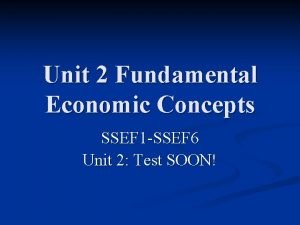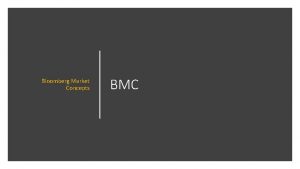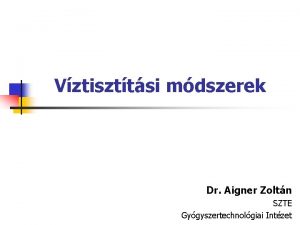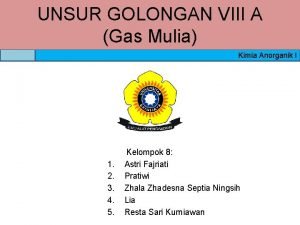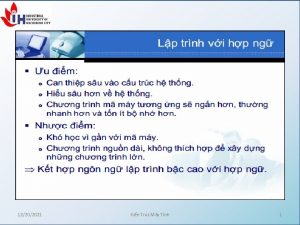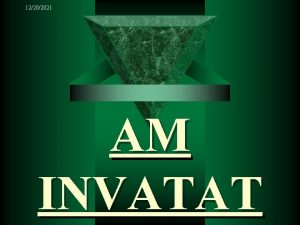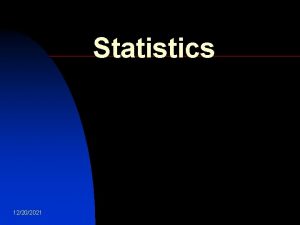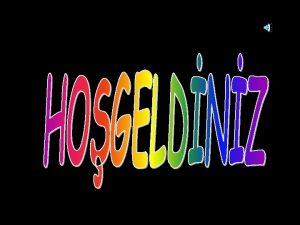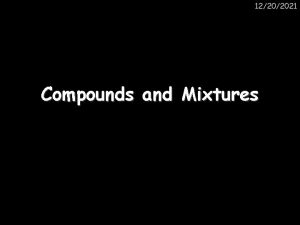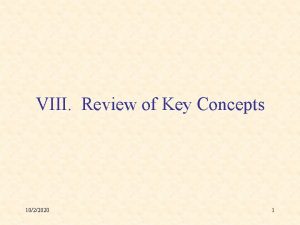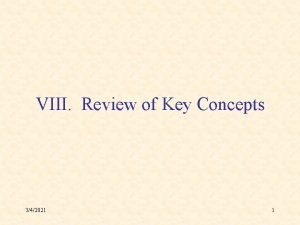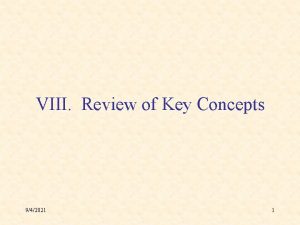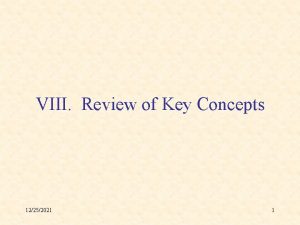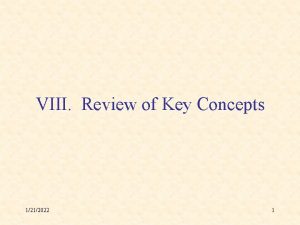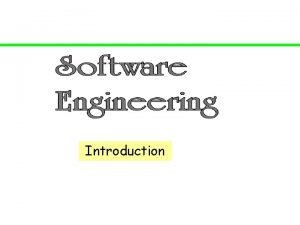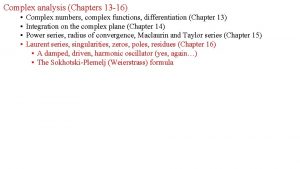VIII Review of Key Concepts 12202021 1 Complex














- Slides: 14

VIII. Review of Key Concepts 12/20/2021 1

Complex Systems • • • Many interacting elements Local vs. global order: entropy Scale (space, time) Phase space Difficult to understand Open systems 12/20/2021 2

Many Interacting Elements • Massively parallel • Distributed information storage & processing • Diversity – avoids premature convergence – avoids inflexibility 12/20/2021 3

Complementary Interactions • • • Positive feedback / negative feedback Amplification / stabilization Activation / inhibition Cooperation / competition Positive / negative correlation 12/20/2021 4

Emergence & Self-Organization • Microdecisions lead to macrobehavior • Circular causality (macro / micro feedback) • Coevolution – predator/prey, Red Queen effect – gene/culture, niche construction, Baldwin effect 12/20/2021 5

Pattern Formation • • • Excitable media Amplification of random fluctuations Symmetry breaking Specific difference vs. generic identity Automatically adaptive 12/20/2021 6

Stigmergy • Continuous (quantitative) • Discrete (qualitative) • Coordinated algorithm – non-conflicting – sequentially linked 12/20/2021 7

Emergent Control • Stigmergy • Entrainment (distributed synchronization) • Coordinated movement – through attraction, repulsion, local alignment – in concrete or abstract space • Cooperative strategies – nice & forgiving, but reciprocal – evolutionarily stable strategy 12/20/2021 8

Attractors • Classes – point attractor – cyclic attractor – chaotic attractor • Basin of attraction • Imprinted patterns as attractors – pattern restoration, completion, generalization, association 12/20/2021 9

Wolfram’s Classes • • Class I: point Class II: cyclic Class III: chaotic Class IV: complex (edge of chaos) – persistent state maintenance – bounded cyclic activity – global coordination of control & information – order for free 12/20/2021 10

Energy / Fitness Surface • Descent on energy surface / ascent on fitness surface • Lyapunov theorem to prove asymptotic stability / convergence • Soft constraint satisfaction / relaxation • Gradient (steepest) ascent / descent • Adaptation & credit assignment 12/20/2021 11

Biased Randomness • • • Exploration vs. exploitation Blind variation & selective retention Innovation vs. incremental improvement Pseudo-temperature Diffusion Mixed strategies 12/20/2021 12

Natural Computation • • • Tolerance to noise, error, faults, damage Generality of response Flexible response to novelty Adaptability Real-time response Optimality is secondary 12/20/2021 13

Student Course Evaluation! 12/20/2021 14
 Chapter review motion part a vocabulary review answer key
Chapter review motion part a vocabulary review answer key Bruno dislikes sitting on the beach
Bruno dislikes sitting on the beach Ghon complex and ranke complex
Ghon complex and ranke complex Simple compound complex quiz
Simple compound complex quiz Oedipus complex and electra complex
Oedipus complex and electra complex Psychodynamic theory of personality
Psychodynamic theory of personality Type a and type b personality theory
Type a and type b personality theory Key resources examples
Key resources examples Key partners
Key partners Ssef price list
Ssef price list Bloomberg market concepts
Bloomberg market concepts Aqua purificata ph.hg. viii
Aqua purificata ph.hg. viii Kegunaan kripton
Kegunaan kripton Henry viii family tree
Henry viii family tree Nervio vago
Nervio vago









